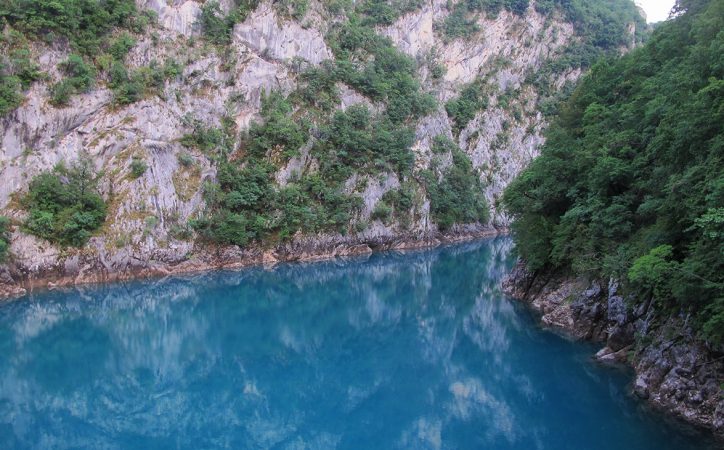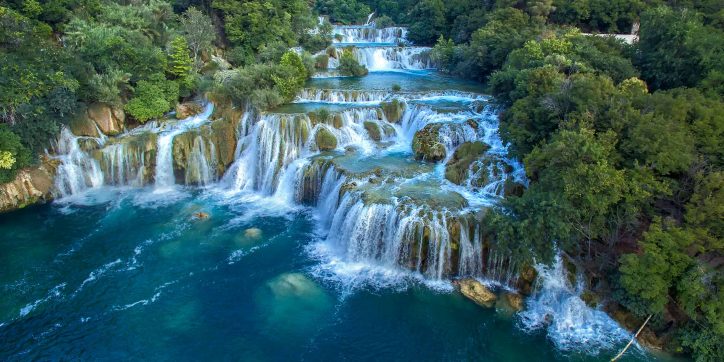Fishing fans have an idea of what the coast of the Adriatic Sea is. But the beauty and the endless variety of mainland landscapes a few dozen kilometers from the coast are almost never included in the vacation program even of ordinary tourists. In terms of fishing, freshwater bodies are not that popular on the Internet and the information concerning them is presented on languages unknown to the reader in most cases. adriaticnature considers such a situation to be absolutely unfair, since the opportunities for fishing, while being surrounded by mind-blowing landscapes, shouldn’t be hidden and lost with the magic of the Adriatic Sea in the background, which often doesn’t let you leave its seaside even for a couple of days.

(Lake Plav, Montenegro. Photo by © adriaticnature)
The lakes and rivers of Albania, Bosnia and Herzegovina, Slovenia, Croatia, Montenegro and Italy are often real natural gems. Moreover, they surprise tourists with the diversity of their inhabitants.
In this article, adriaticnature will gloss over the rivers and lakes of these countries, and share general information about their inhabitants. Further, adriaticnature will try to dwell on significant and interesting water bodies in detail. Besides, we’ll describe the inhabitants of fresh waters.
Numerous lakes of the Balkan Peninsula differ in origin and features greatly. The largest lakes are located in the tectonic depressions of the south-eastern part of Montenegro, Albania and Macedonia (Lake Skadar (Scutari), Lake Prespa, etc). These lakes are shallow, most of them have bank slough. The lakes are mainly fed on the river water in the course of the winter rains, so the highest level is observed in spring. In summer, the lakes become very shallow.
Karst lakes, situated in depressions, formed due to the dissolution of limestone rocks, are typical here. In most cases, karst lakes are small and don’t have external drain: these lakes are mainly fed on groundwater; their level fluctuates significantly and very irregularly. Some karst lakes occur periodically. They fill with water, and drain off later.

(Lake Garda, Italy. Photo by © airdolomiti.eu)
Lakes of glacial origin are located in the mountainous regions of the Balkan Peninsula. However, the largest glacial lakes are situated on the Apennine peninsula in the north of Italy. Lake Garda is the largest and most famous.
Lake Skadar (Scutari) is the largest lake on the Balkan and Apennine Peninsulas, located in two countries, including Montenegro and Albania. Its surface area is 390 sq. km.
Lake Garda in Italy is the second largest lake. It is slightly smaller than Lake Skadar. Its surface area is 370 sq. km.
Lake Prespa (a part of the lake is in Albania, another part is in Greece, and the third part is in Macedonia) with a surface area of 276 sq. km is the third largest lake. And Lake Maggiore, the largest part of which is in Italy, with a surface area of 212 sq. km is the fourth largest lake.
There are many river (impounding) reservoirs on the Balkan and the Apennine Peninsulas.


(The Danube in the territory of Croatia. Photo by © radio-dunav.com)
The Danube river system is the most important river system on the territory of the Adriatic countries. The Danube is the second longest river in Europe (the Volga is the longest one). It is 2,860 km long. Despite the fact that the Danube flows only through the territory of Croatia, most of the rivers in other Balkan countries (in which adriaticnature is interested), as well as in Croatia, are its tributaries. The Drava (Italy, Slovenia, Croatia), Sava (Slovenia, Croatia, Bosnia and Herzegovina) are the largest ones. The latter ones have a lot of rather large tributaries as well.
Other rivers, we are interested in, run into the Adriatic Sea. The longest river is the Po (Italy), it is 652 km long. The second longest river flows through Italy too. It’s the Adige, which is 410 km long. The third longest river flows from the Balkan Peninsula in the territory of Albania. The Vjosë is 280 km long. Besides, such rivers as: the Aterno-Pescara, Biferno, Brenta, Carapelle, Marano, Metauro, Ofanto, Potenza, Piave, Reno, Rubicon, Sangro, Tenna, Trigno, Tronto, Foglia, Esino from Italy and Bojana, Drin, Zrnovnica, Zrmanja, Krka, Neretva, Reka, Soča, Seman, Cetina, Shkumbin, Erzen from the Balkan Peninsula, are important too.

(Waterfall in the Krka river, Croatia. Photo by © croatia.hr)
Despite the fact that the Adriatic countries seem to occupy a rather small territory, there are more than 200 fish species in their fresh waters. There is a huge number of endemic species among them. Unfortunately, they are often listed in the IUCN Red List.
adriaticnature will try to describe all fish species found in the waters of Albania, Bosnia and Herzegovina, Slovenia, Croatia, Montenegro and Italy, that is, all the states, the water bodies of which are a subject matter of our resource.
In this article, adriaticnature will provide you with a general idea of the fish species that will be described further.
The following fish species inhabit the freshwater bodies of the countries mentioned above:
more than 30 representatives of the Salmonidae family;
more than 100 representatives of the Cyprinidae family;
15 representatives of the Cobitidae family;
more than 10 representatives of the Gobiidae family;
8 representatives of the Percidae family,
as well as representatives of the following families: Acipenseridae, Esocidae, Umbridae, Nemacheilidae, Blenniidae, Centrarchidae, Cichlidae, Cottidae, Ictaluridae, Siluridae, Lotidae, Cyprinodontidae, Poeciliidae, Valenciidae, Atherinopsidae, Gasterosteidae, Clupeidae, Anguillidae and Petromyzontidae.